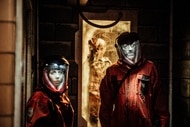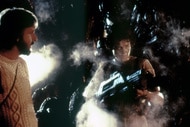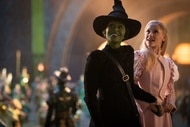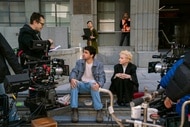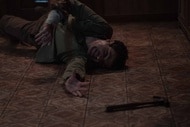In Praise of Men in Black II's Schlocky Light of Zartha Video Tape
RIP Tapeworm Video.

Some movies are just made in the right place at the right time, and no matter how hard you try, you'll never be able to recapture the strange alchemy that made it such a hit — financially and culturally — in the first place. Men in Black (now streaming on Peacock) is a great example of that philosophy.
Despite the best laid plans of aliens and men, the subsequent MiB films (released in 2002, 2012, and 2019, respectively) could never quite emulate the perfect storm of everything that made the 1997 original so great. Specifically, the effortless, contrasting chemistry between Tommy Lee Jones and a young Will Smith (at the very start of his blockbuster career) which proved to be an once-in-a-lifetime phenomenon. In keeping with the franchise's themes of cosmic wonderment, it was the Haley's Comet of onscreen pairings.
For More on Men in Black:
Making an Edgar suit, the science behind 'Men in Black's insectoid aliens
Despite longstanding rumors, the Worm guys in 'Men in Black' are not related to Jabba the Hutt
'Men in Black' director, production designer look back on 'hardest' thing to pull off in sci-fi classic
Men in Black Writer Explains Why the Original Film Is So Special
While nearly every member of the core team — behind and in front of the camera — reunited to continue the series with Men in Black II (also streaming on Peacock alongside Men in Black 3), Ed Solomon did not return as screenwriter, which may have sealed the project's fate.
"It seems to me like the sequels weren’t dealing with the humanity of the [first] movie," Solomon told Den of Geek in 2021. "The other thing that I really loved in writing the first Men in Black was that it really was about how we humans think we’re so important, but in fact we don’t know anything that’s really going on. And so, that was a very human experience, and to me, the story of Men in Black was about a cocky human being who gets humbled and realizes that he ain’t even close to the center of the universe. In fact, the universe, the world, what’s important, is nothing that he ever thought about. Reality isn’t anything like he ever thought. It’s a humbling blow. It’s a very human experience."
Written by the duo of Robert Gordon and Barry Fanaro, Men in Black II sees Agent J (Smith) bringing the venerable Agent K (Jones) out of retirement when a tendrilled baddie known as Serlena (Lara Flynn Boyle) touches down on Earth, looking for a powerful MacGuffin known as the "Light of Zartha." While bringing K back into the fold is a fun idea, of course, but it essentially ignores the whole point of the first movie, minimizing the character arcs of K and his protégé. If you can get past that little snag, though, the sequel delivers a breezy little detective story cleverer than most fans give it credit for.
Why Men in Black II Is Even Better (and Cleverer) Than You Might Think
Even after K gets his memories back (with a little helping hand from Tony Shalhoub's Jack Jeebs), we learn the veteran agent willingly neuralyzed himself years before to keep sensitive information about the Light of Zartha from reaching malevolent ears. The storytelling is a little wonky here, given that all of his recollections should have returned in the process of de-neuralization, but, in any case, this kicks off an entertaining scavenger hunt of sorts across Manhattan.
The partners start at a pizza joint and discover a mini-civilization inside a locker at Grand Central Station before ultimately finding themselves at a rundown video rental establishment, Tapeworm Video, where K once reserved a tape he never checked out. Said cassette contains an episode of Mysteries in History, a hilariously shlockly TV show about unexplained events hosted by Mission: Impossible actor Peter Graves. Held amongst the extensive private collection of Tapeworm manager Newton (played by David Cross, who also had a small supporting role in the '97 original), the episode provides a fictionalized reenactment of how the Men in Black kept Serena from wrapping her slimy tentacles around the Light of Zartha back in the late '70s. The video, as it turns out, is the key to kickstarting K's hippocampus.
It's a brilliant and clever storytelling device that imparts much-needed exposition in an unusually memorable way without having to rely on traditional blocks of spoken dialogue. Moreover, the tape beautifully enhances the wider MiB mythos by implying the quasi-government agency leaked the general beats of the Zartha mission to the makers of the low-budget Mysteries in History as a way to discredit conspiracy theorists who believe in secret alien cover-ups. Or, perhaps, Men in Black was the production company behind the show from the very start.
A similar thought occurs to J in the official Men in Black II tie-in novelization by Esther M. Freisner:
"Jay watched, marveling at the beauty of it all. It was Edgar Allan Poe's gambit from 'The Purloined Letter': There's no better place to hide than in plain sight. Make a videotape that reveals the truth about the Men in Black, but make it to look like the lowest of low-budget sci-fi featurettes, and no one would ever believe it, except for the eccentrics, cranks, nut cases, and 'woo-woos.'"
Wait... what were we talking about? Oh, well. Anyone else feel like going to Camobia for a lobster dinner?
The Men in Black trilogy is now streaming on Peacock.




